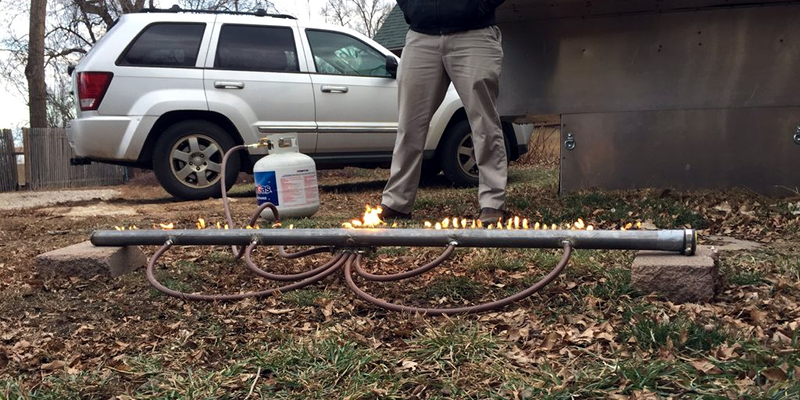If you want to visualize sound waves, you reach for your oscilloscope, right? That wasn’t an option in 1905 so physicist [Heinrich Rubens] came up with another way involving flames. [Luke Guigliano] and [Will Peterson] built one of these tubes — known as a Rubens’ tube — and will show you how you can, too. You can see a video of their results, below. Just in case a flame oscilloscope isn’t enough to attract your interest, they are driving the thing with a theremin for extra nerd points.
The guys show a short flame run and one with tall flames. The results are surprising, especially with the short flames. Of course, the time base is the length of the tube, so that limits your measurements. The tube has many gas jets along the length and with a sound source, the height of the flames correspond to the air pressure from the sound inside the tube.
According to their plans, the tube is a 2 inch tube, six feet long. They used a #42 drill bit to create the gas jet holes an inch apart although they mention if they did it again they’d go smaller and space them closer. The working gas is propane and if you want to exactly duplicate their build, you’ll need to weld. They mention, though, that you could probably build it without welding. Total cost? About $350.
You can extend the idea of a Rubens’ tube to a square — we hate to call it a Rubens’ cube. Or you can shrink it down to a single point. Either way, it is fire, so you want to be careful, but there is a certain appeal to it, too. It always amazes us how resourceful people can be when they have to be. The invention of the Rubens’ tube is an example of that, although there were many other ways people made up for not having oscilloscopes.
















I saw this idea in Nigel Stanfordd’s video Cymatics
https://youtu.be/Q3oItpVa9fs
Great video!
Anything to make a theremin seem cool ;)
Anyway, I wonder if the problem of only half the tube emitting flames at low frequencies couldn’t be solved by increasing the gas jet hole diameter as a function of distance from speaker?
Ever since The Beach Boys used a theremin in their song Good Vibrations in the 60s, the coolness can never be reversed or undone.
So, I want to see them toast a Reuben sandwich on the Ruben tube.
Do it in a Ruben square then you can specify song rather than degree of toastedness
Neato nice idea, though has me thinking of odd ball variants which won’t let me sleep easily…
So if you extend the concept to involve some precision metalworking, couldn’t you produce a continuous waveform by milling a very narrow continuous slit in the tube?
I think that the design has persisted with drilled holes because of the relative ease of construction, but HAD has some pretty clever machinists out there…
I think you need individual jets instead of a slit due to interference of the escaping gas molecules. With jets they would mostly travel in a singular direction, spreading out once the gas leaves the nozzle. With a singular slit the gas molecules would escape along a 2d plane and wouldnt give you the same results. I could be wrong though.
Huh… no comments on my bad pun. I’m surprised.
well, it was kinda bad… ;-)
I think I audibly groaned when I saw it, but I admit I started visualizing putting 6 of those into a cube form and tried to figure out what it could be used for.
Is it just me or does anyone else think this thing would make a cool fireplace (with bluetooth connectivity to play your tunes through?)
The problem is of length. To see anything of interest you’ll need a really long. All your bass notes which would give the most noticable effect with the beat have too long a wavelength. They would also make most of the action happen on 1 end of a short tube with pretty much zero flame on the other. There’s a reason Rubens tubes are meters long.
Can Ruben’s tubes be folded?
I like how you have to go through the flames to get to the fire extinguisher!
“#42 drill bit” is even weirder than then the strange fractional imperial units. At least there is a conversion formula fur them. Why not use a diameter value?, best of course would be in SI units.